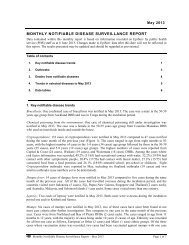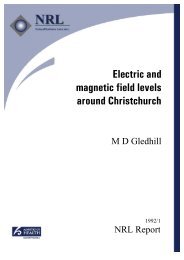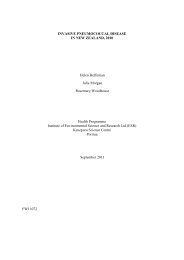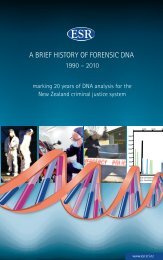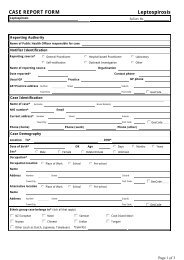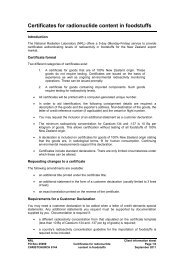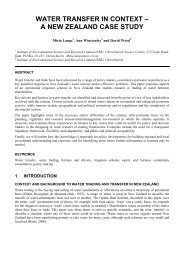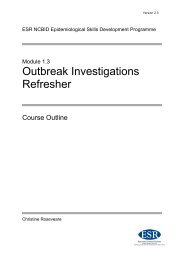environmental health indicators for new zealand: feasibility study
environmental health indicators for new zealand: feasibility study
environmental health indicators for new zealand: feasibility study
Create successful ePaper yourself
Turn your PDF publications into a flip-book with our unique Google optimized e-Paper software.
1. INTRODUCTIONThe goal of the project as articulated in the service description is to develop a functional coreset of <strong>environmental</strong> <strong>health</strong> <strong>indicators</strong> [EHI’s] <strong>for</strong> New Zealand, the major outcome being afunctional interactive database, incorporating multiple data sets providing timely data todifferent organisations <strong>for</strong> decision making.This process as outlined in the previous report [FW0192] has two principal phases, namely:I. Creation of base line dataset in environment <strong>health</strong>:• Literature review of frameworks• Audit and report on current available dataII. Construction of a prototype set of <strong>environmental</strong> <strong>health</strong> <strong>indicators</strong>:• Design a model database of <strong>indicators</strong>• Identify key issues in consultation with an expert panelThe previous report addressed phase I above recommending the adoption of the WHO-Europe DPSEEA Indicators framework. This report uses that framework to address thefollowing milestones in the 2002/3-service description:• Form project working group and map stakeholder needs and activities. Consult onidentified existing and missing data sources and data quality issues within theEnvironmental Health Strategy framework.• Describe elements, structure, and process of a national <strong>environmental</strong> <strong>health</strong> <strong>indicators</strong>ystem in consultation with the MoH service description leader, including proposed<strong>indicators</strong> <strong>for</strong> New Zealand based on the WHO model but incorporating NZ priorities,existing data sources, and data gaps, and including incorporating appropriaterecommendations of the Public Health Advisory Committee when available.Specifically this report:• Critically reviews the WHO indicator sets from a New Zealand perspective.• Determines the gaps in the NZ data with respect to the WHO dataset.• If appropriate, suggests alternative <strong>indicators</strong> and data sets.• Describes key elements of the next phase of the work. .Environmental Health Indicators 4 18 December 2003<strong>for</strong> New Zealand




